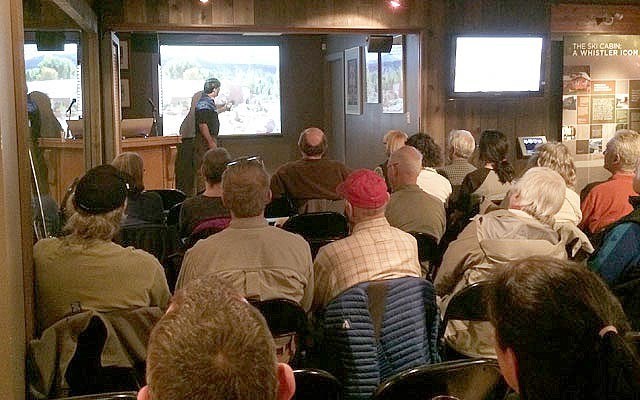When it comes to geology, there's a lot to be learned from Whistler's lakes.
For Ian Spooner, head of the Department of Earth and Environmental Science at Acadia University, the lakes contain stories dating back thousands of years.
More specifically, they could hold information about past landslide events in Fitzsimmons Creek.
"What we look for are archives of these events — some place that captures these events through time, and records them," Spooner said, after a presentation on landslides in the Sea to Sky at the Whistler Museum on April 8.
Green Lake and Alta Lake could provide such an archive, Spooner said.
"Both of those lakes, they're deep, and so anything that happens and goes into them, the lake captures it and keeps it and holds on to it," he said. "The other thing (we could do) is look at the geotechnical records in town and see if there's any geotechnical evidence that the sediment that the town was built on was old debris flow sediment."
It's not that Whistler is in any kind of imminent danger when it comes to a major landslide event — Spooner believes quite the opposite — but knowing more about past events could prove beneficial in preparing for that possibility.
"I certainly don't think that this kind of work is critical for the safety of Whistler," he said. "It just provides just a little bit more texture to making decisions, especially with any new development."
Spooner is in the process of putting together funding to carry out research projects on both Green Lake and Alta Lake.
If successful, he and some of his students would spend time in Whistler taking core samples of the lakes, likely in the summer of 2016.
"The work we do is coring," he said. "It's called paleolimnology. It's a big word, but all that means is old lake records, and that's what we do."
Having access to historical records concerning the activity of Fitzsimmons Creek — potentially going back 10,000 years — would help scientists and engineers better understand if landslides are a recurring event in the valley.
"Perhaps we'll find something in our lakes that tell us... 'woah, we've had a huge event in the past and we're under-engineered on this with what we've got,'" Spooner said.
"Or perhaps we'll say 'Nope, we've got what we need and the likelihood of something happening is one every two or three hundred years, and that's fine. We're in good shape.'"
Either way, doing the kind of work Spooner envisions would allow the municipality to better engineer itself to deal with potential landslides.
"Most of the geotechnical work that's done most of the time, they look at what's happening right now and engineer to prevent an incident," he said.
"What I'm more interested in is looking at what's happened in the past, so we can understand how the incident occurs.
"I think it would inform us and give us a different perspective on the work that's been done and perhaps the need for future work."
As it stands right now, Spooner said he believes Whistler is well engineered for any potential events.
"I think that what's in place is perfectly adequate for the situation that we see right now," he said. "My interest in it is... have there been potentially bigger events in the past? Have there been a lot of events in the past?
"That would colour how we take a look at a way forward with development, and where we develop."
Some communities in the lower Sea to Sky corridor were developed in very high-risk areas, Spooner said.
"What always has surprised geoscientists is why that risk wasn't identified, and it's really that there's not a lot of geoscientists out there and there's a lot of developers out there," he said. "And people just aren't aware of where risk is and where risk isn't."
But identifying and quantifying risk can be tricky, Spooner said.
"The only way you can really figure that out is by going back in time and figuring out how often these things occur," he said.
"I don't think there's anything here that's any more risky than living in, let's say, Los Angeles or San Francisco, and in fact, it's a lot less risky, but in terms of just managing risk and understanding where to put your dollars and how to inform people, those are the challenges, because it's hard to get the data to be able to do that effectively."




